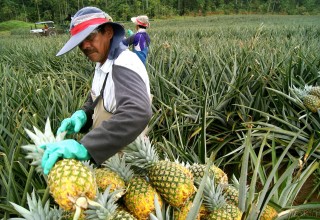Buyers of Costa Rican Pineapples Can Now Guarantee a Deforestation-Free Commodity to Their Customers Around the World

SAN JOSE, Costa Rica, February 22, 2018 (Newswire.com) - As consumers become increasingly concerned about the environmental impact of agro-commodity production, with the click of a button, companies buying pineapples from Costa Rica – one of the world’s largest producers of the fruit – can now see if their suppliers are engaged in deforestation or not, with help from the United Nations' Green Commodities Programme.
The Land Use Change Monitoring System within Production Landscapes (MOCUPP) (http://www.mocupp.org), developed with support from the United Nations Development Programme's (UNDP) Green Commodities Programme, is the world’s first to overlay satellite images with land registry records on an annual basis for an entire national territory. Now, every year, the system will produce images showing forest loss and gain from pineapple production in Costa Rica, with more agro-commodities soon to be added to the system.
This new tool is free for commodity buyers to use. Buyers can easily check if their producers are engaged in illegal deforestation, or if they are increasing deforestation cover. The system allows buyers to check this using their own internal records. This avoids any risk related to commercial confidentiality agreements, as there is no need to provide geo-positioning data to any government entity.
Pineapple farmers producing for export who are doing the right thing also stand to benefit. The new tool allows them to show that their farms are deforestation-free, enabling them to benefit from incentive schemes such as the Payment of Ecosystem Services by the National Forestry Financing Fund.
Costa Rica is one of the world’s biggest pineapple-producing countries. MOCUPP is part of a wider national effort to tackle serious social and environmental concerns in this critical sector, worth US$800 million to the national economy.
Already, MOCUPP has developed imagery showing the rapid spread of pineapple cultivation in Costa Rica between 2000 and 2015. It reveals that over the past 15 years, the country has lost more than 5,000 hectares of forest cover, the size of over 3,000 football pitches, due to the expansion of pineapple farming.
The system is also currently developing baselines and annual monitoring for other agro-commodities, including pasture and palm oil plantations. The aim is that by 2020, all of Costa Rica’s major commodity exports will be monitored on an annual basis for deforestation activity. An annual set of images generated by MOCUPP will be published through the National Territorial Information System web tool (http://www.snitcr.go.cr), accessible by the public. Meanwhile, property records where forest loss or gain has occurred will be made available to authorities and private sector buyers.
The Ministry of Environment, the National Registry, the National Geographical Institute and the Center of High Technology of Costa Rica, with support from the UNDP Green Commodities Programme, UNDP REDD and the Global Environment Facility developed the system.
It has generated keen interest from the governments of Paraguay, Madagascar, Morocco and Côte d’Ivoire, who are also facing the challenge of reducing deforestation from valuable commodity supply chains. The UNDP Green Commodities Programme is now working with these countries to replicate this system.
To find out more about the system: visit http://www.snitcr.go.cr.
For further information, please contact:
UNDP Green Commodities Programme
GCP Communications Advisor, Elisabeth Hiller at Elisabeth.hiller@undp.org or UNDP Environment Programme Manager Kifah Sassa: kifah.sassa@undp.org
Website: www.greencommodities.org
Follow us: @undpcommodities
Source: UNDP Green Commodities Programme


